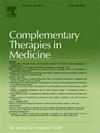Effectiveness of acupuncture on glycolipid metabolism in patients with coronary heart disease: A systematic review and meta-analysis
IF 3.3
3区 医学
Q1 INTEGRATIVE & COMPLEMENTARY MEDICINE
引用次数: 0
Abstract
Objective
Disorders of glycolipid metabolism are important pathogenic factors leading to coronary artery disease, and there is no safe and effective comprehensive treatment, while acupuncture has a certain efficacy in heart disease and disorders of glycolipid metabolism. To assess the effects of acupuncture on glycolipid metabolism in patients with coronary heart disease, we conducted a systematic review and meta-analysis.
Methods
From the time of library construction to August 18, 2023, Searches were conducted in eight databases, with no language restriction. Only RCTs that included acupuncture as a sole or secondary effect on glucose-lipid metabolism in coronary heart disease were included.Our primary outcome indicators were Low-density lipoprotein cholesterol(LDL-C), Hemoglobin A1c(HbA1c). Our analyses were conducted in strict accordance with the PRISMA statement, and the researchers used the Cochrane Handbook for literature screening and data extraction, the “Risk of Bias” tool (ROB.2) for assessing risk of bias, and RevMan (version 5.3) for meta-analysis of outcome metrics, and the GRADE criteria for assessing quality of evidence. Assessing the quality of acupuncture literature using the Standards for reporting interventions in clinical trials of acupuncture.
Results
Our analysis included 18 eligible RCTs (N = 1346 participants). For the primary outcome metrics, acupuncture combined with standard treatment was effective in reducing LDL-C (SMD =-0.56; 95 % CI, −0.75 to −0.38; P < 0.00001), and HbA1c (MD = −1.15; 95 % CI, −1.73 to −0.58; P < 0.0001). For secondary outcome measures, combination therapy improved TC (SMD = −0.97; 95 % CI, −1.44 to −0.51; P < 0.0001), TG (MD = −0.39; 95 % CI, −0.58 to −0.20; P < 0.0001), hs-CRP (MD = −0.98; 95 % CI, −1.43 to −0.52; P <0.0001), 2hPG (MD = −1.45; 95 % CI, −1.74 to −1.16; P < 0.00001), and ORR (RR, 1.27; 95 % CI, 1.19–1.36; P < 0.00001) levels more than standard therapy alone.However, the combination therapy did not prevail in lowering HDL-C (MD = 0.11; 95 % CI, 0.07–0.14; P < 0.00001) compared with standard therapy alone. Meanwhile heterogeneity analysis showed that After coronary heart disease intervention, acupuncture was able to reduce TC (SMD = −0.85; 95 % CI, −1.37 to −0.33; P = 0.001), TG (MD = −0.14; 95 % CI, −0.24 to −0.04; P = 0.004) levels, but did not dominate in lowering LDL-C.
Conclusions
Acupuncture effectively regulates glycolipid metabolism in coronary artery disease, serving as an adjuvant treatment. It may aid post-PCI healing via lipid metabolism regulation, but rigorous, large-scale, long-term RCTs are needed for validation.
针刺对冠心病患者糖脂代谢的影响:系统综述和荟萃分析
目的:糖脂代谢紊乱是导致冠状动脉疾病的重要致病因素,目前尚无安全有效的综合治疗方法,而针刺对心脏病及糖脂代谢紊乱有一定疗效。为了评估针灸对冠心病患者糖脂代谢的影响,我们进行了系统回顾和荟萃分析。方法:自建库时起至2023年8月18日,在8个数据库中进行检索,不受语言限制。仅纳入了将针灸作为冠心病患者糖脂代谢的唯一或次要影响的随机对照试验。我们的主要结局指标是低密度脂蛋白胆固醇(LDL-C)、血红蛋白A1c(HbA1c)。我们的分析严格按照PRISMA声明进行,研究人员使用Cochrane手册进行文献筛选和数据提取,使用“偏倚风险”工具(rob2)评估偏倚风险,使用RevMan (version 5.3)进行结果指标的荟萃分析,并使用GRADE标准评估证据质量。使用针灸临床试验干预措施报告标准评估针灸文献的质量。结果:我们的分析纳入了18项符合条件的随机对照试验(N = 1346名受试者)。对于主要结局指标,针灸联合标准治疗可有效降低LDL-C (SMD =-0.56;95% CI, -0.75 ~ -0.38;P < 0.00001), HbA1c (MD = -1.15;95% CI, -1.73 ~ -0.58;P < 0.0001)。对于次要结局指标,联合治疗改善TC (SMD = -0.97;95% CI, -1.44 ~ -0.51;P < 0.0001), tg (md = -0.39;95% CI, -0.58 ~ -0.20;P < 0.0001), hs-CRP (MD = -0.98;95% CI, -1.43 ~ -0.52;结论:针刺可有效调节冠心病患者的糖脂代谢,可作为辅助治疗。它可能通过脂质代谢调节来帮助pci后的愈合,但需要严格的、大规模的、长期的随机对照试验来验证。
本文章由计算机程序翻译,如有差异,请以英文原文为准。
求助全文
约1分钟内获得全文
求助全文
来源期刊

Complementary therapies in medicine
医学-全科医学与补充医学
CiteScore
8.60
自引率
2.80%
发文量
101
审稿时长
112 days
期刊介绍:
Complementary Therapies in Medicine is an international, peer-reviewed journal that has considerable appeal to anyone who seeks objective and critical information on complementary therapies or who wishes to deepen their understanding of these approaches. It will be of particular interest to healthcare practitioners including family practitioners, complementary therapists, nurses, and physiotherapists; to academics including social scientists and CAM researchers; to healthcare managers; and to patients. Complementary Therapies in Medicine aims to publish valid, relevant and rigorous research and serious discussion articles with the main purpose of improving healthcare.
 求助内容:
求助内容: 应助结果提醒方式:
应助结果提醒方式:


